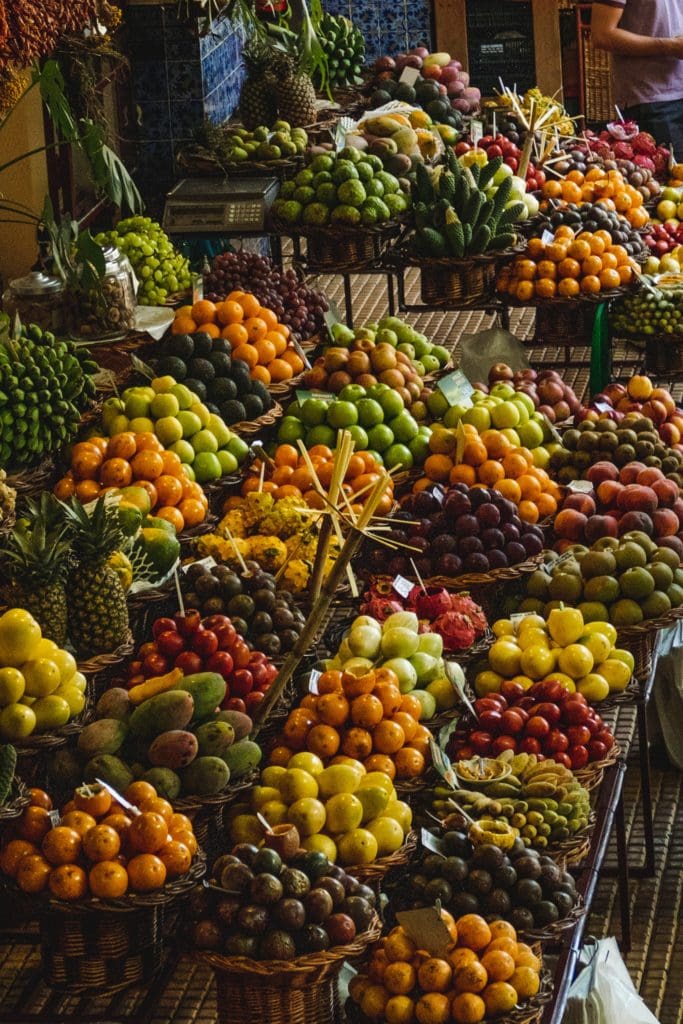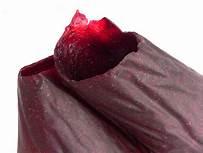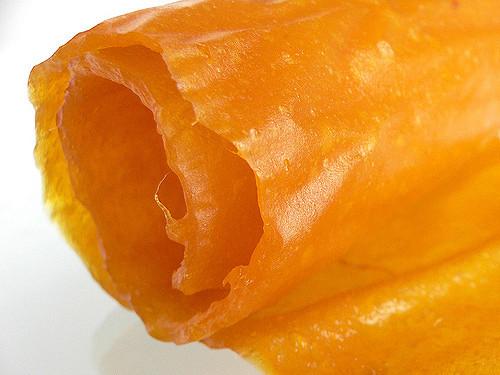They are basically dried fruit puree. Chewy, tasty, full of fruity goodness. They are called fruit leathers because the dried fruit puree’s texture and shine are like that of a true leather hide.
In this article, we will share with you how to make fruit leather at home. This could be a good start in your food dehydration journey because it’s easier to do.
Not only it is much easier to make, but it also saves you money because you may use leftover or overripe fruit, use less sugar if you wish, and buy less of the commercially available fruit roll-ups.

Table of Contents
Leather From Fresh Fruits
As we mentioned earlier, you can save money by using leftover or overripe fruits. Wash them in cool water then peel off, remove the stems and seeds. Cut fruits into chunks and place them in a food processor or blender. Add 2 teaspoons of lemon juice or ⅛ teaspoon ascorbic acid for every 2 cups of fruit as pre-treatment. Use 2 cups of fruit for every 13″ x 15″ fruit leather. Puree fruit until smooth.
If you wish to add more to the fruit’s natural sweetness, you may add corn syrup, honey, or sugar. Use sugar for short-term storage only. It is best to use natural honey or corn syrup to prevent crystals from forming. Use ¼ to ½ cup of chosen sweetener for every 2 cups of fruit.
RELATED ARTICLE: A Beginner’s Guide on How to Dehydrate Fruits
Leather From Canned Fruits
The easiest part of this food dehydration is that you could use canned or frozen fruit. Just drain the fruit but save the liquid for later use. For every 13″ x 15″ fruit leather, use 1 pint of fruit. Puree the fruit in a food processor or blender until smooth. Add 2 teaspoons of lemon juice or ⅛ teaspoon ascorbic acid for every 2 cups of fruit as pre-treatment. If necessary, use the drained liquid to thin the puree if it becomes too thick.
Drying
Oven Drying
Line the 13″ x 15″ cookie pan with plastic wrap. Do not use waxed paper or aluminum foil. Smooth out wrinkles. Pour out the puree and spread evenly about ⅛-inch thick. Dry inside the oven up to 18 hours, maintaining the temperature between 135°F to 140°F. You may need to prop the oven door up to allow air to circulate.
Food Dehydrator
Few food dehydrators provide specially designed drying trays for making fruit leather when you buy them. Just pour the puree and spread it evenly about ⅛-inch thick onto the tray. If the machine doesn’t come with a fruit leather tray, just line the drying tray with plastic wrap. Avoid pouring the puree too close to the edge. Dry them at 140°F for 6 to 8 hours.
Sun Drying
Line the 13″ x 15″ cookie pan with plastic wrap. Smooth out wrinkles. Pour out the puree and spread evenly about ⅛-inch thick. Cover with a screen to protect it while drying. Dry for 1 to 2 days under the sun.
After Drying

Fruit leather tends to dry from the outside edge towards the center. To test for dryness, touch or press the center. There should be no indentation when pressed. It should be tacky, but not sticky and should not be hard.
While warm, peel it from the plastic and roll or allow it to cool. You may use cookie cutters to shape the fruit roll-ups. Wrap in plastic and store.
Chances are, the fruit leather will not last long. But if it does, it usually keeps up to 1 month at room temperature. For longer storage, wrap fruit leather with plastic tightly and store it in the freezer for up to 1 year.
Spice Up Your Fruit Leather
You can add flavors into your fruit leather to make it more interesting. Use spices, flavorings, and other ingredients to liven up your leather treats.
Spices
Use these spices sparingly because their taste and aroma are too strong. It is recommended to use only 1/8 teaspoon of spice for every 2 cups of fruit puree. Try allspice, cinnamon, cloves, coriander, ginger, mace, mint, and nutmeg.
Other Flavors
These flavors may come too strong if put too much, thus use them sparingly. Put 1/8 to 1/4 teaspoon for every 2 cups of fruit puree. You may use almond or vanilla extract and juices, peels, or zests of citrus fruits (lemon, lime, orange, etc.)
Other Ingredients
Spice up your fruit leather with shredded coconut, chopped nuts, granola, mini marshmallows, chopped raisins, and seeds like sesame and sunflower. These ingredients may not only add flavor but also texture and crunch you’ll love in a snack.
Try Filling
Layer fruit leathers on top of each other by filling melted chocolate, soft cream cheese, jam, preserves, marmalade, melted marshmallows, nut butter or spreads in between before rolling. Store in the refrigerator to chill before serving as a snack.
Final Thoughts
Making your own fruit leather or roll-ups at home is easy. This could be considered a beginner’s introduction to food dehydration because of its ease. Not only it is easy to make, but it is also a good food saver.
It saves you from wasting overripe and leftover fruit or fruit juice. It saves you money from buying commercially available fruit roll-ups that have food preservatives or artificial flavors. Most of all, it’s healthy.

